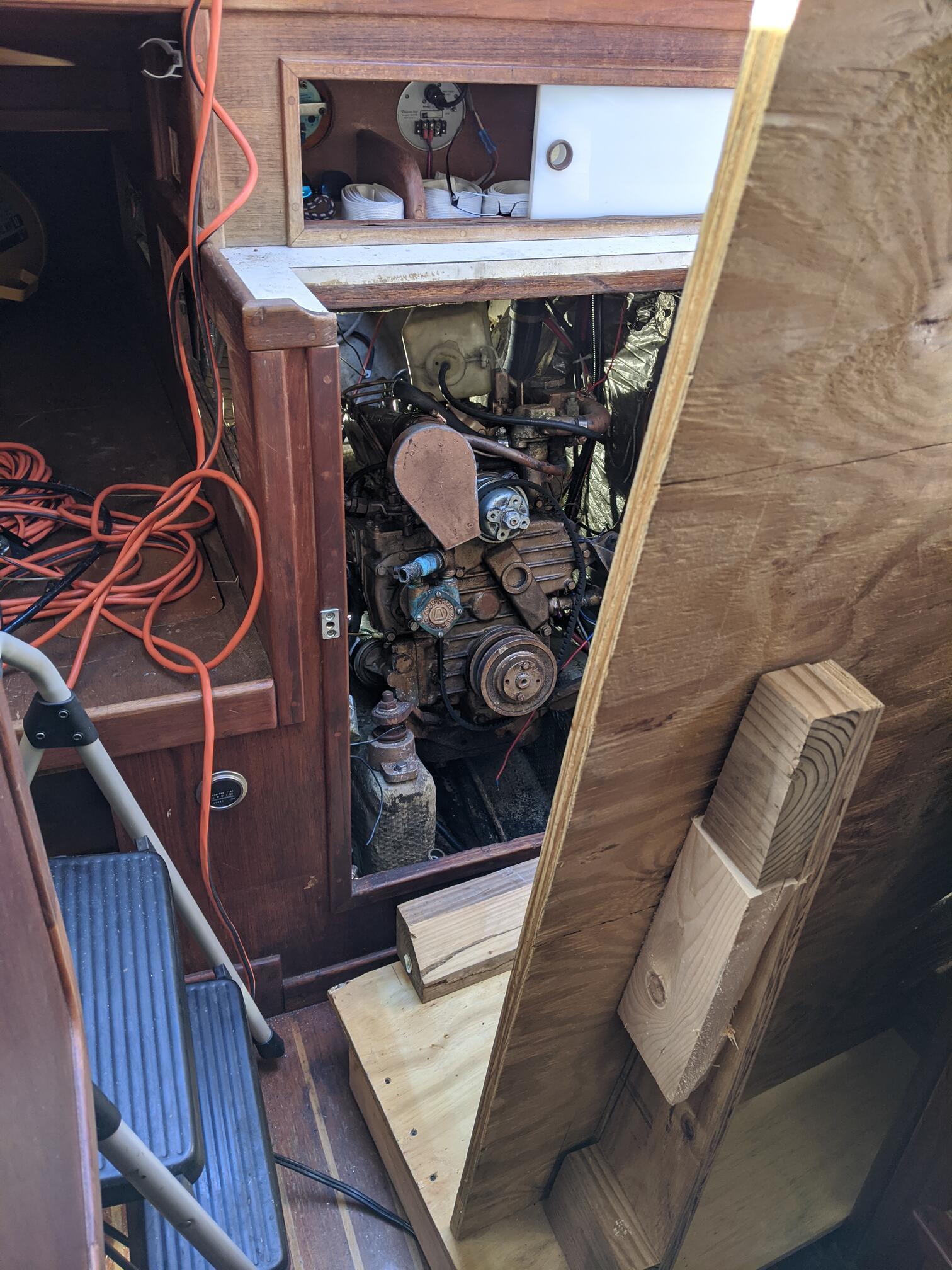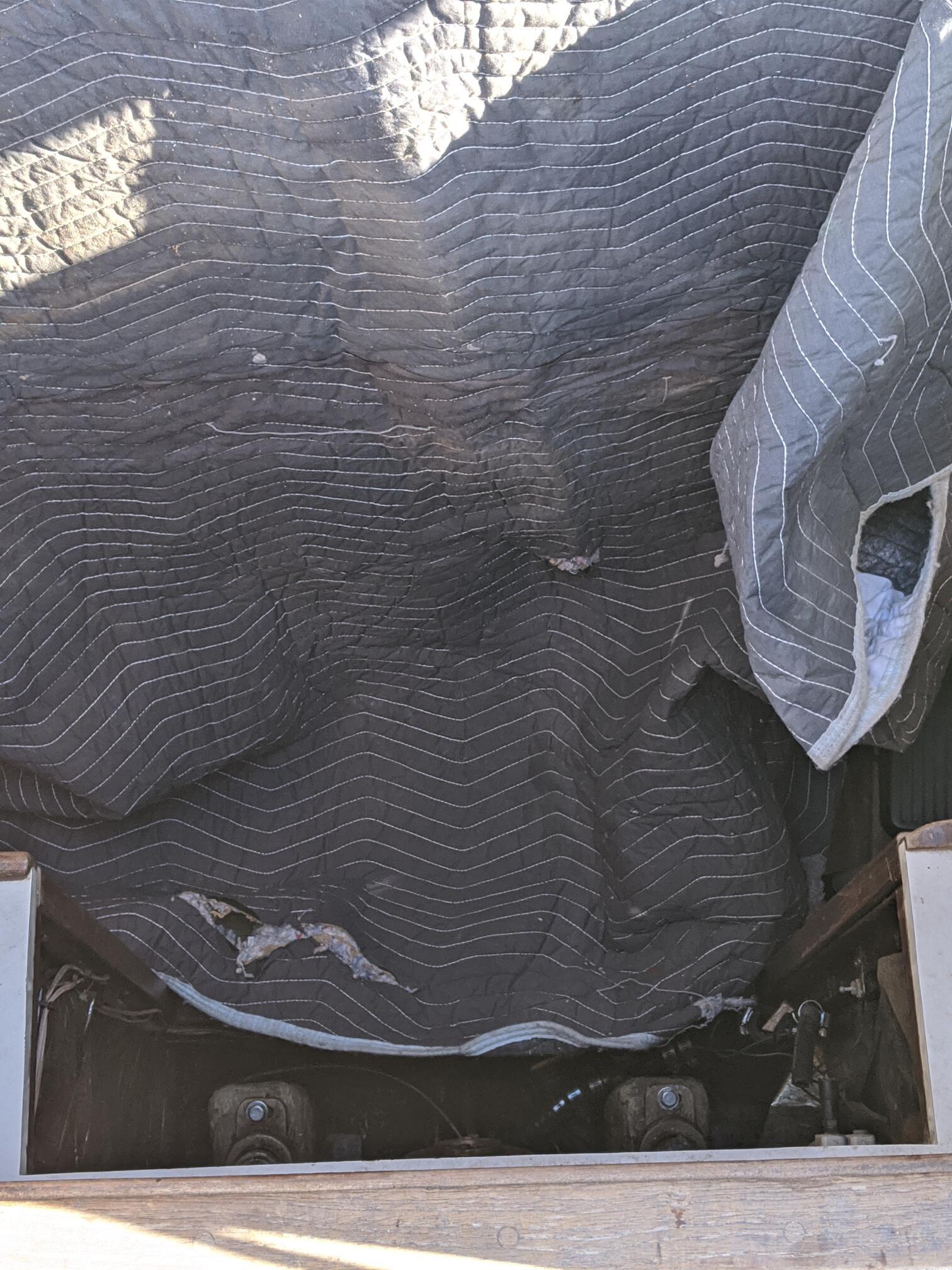Diesel Removal
The diesel in this Mariner Yachts 36 is a Universal Diesel Model 40, also known as the Atomic Four Diesel. The Model is the 40-5432. It is a 91 cubic inch four cylinder diesel rated at 32 HP at 2800 RPM. The engine weighs 545 lbs. Overall dimensions are 35½" long by 22.7" wide by 26.4" high. The engine mounts are 16" spacing and the stringer height follows the hull shape and is significantly high at the forward end of the engine.
These are generally reliable but notoriously tempermental. The engine has nearly 4,000 hours on it (according to the previous owner, though the hour meter reads under 3,000 hours) so is likely old and a bit tired and may be tempermental. Our experience so far is that the engine has started easily with the right touch and having started runs well but with some vibration. It does require a full 30 seconds of glow plug time with an ambient just above freezing (not at all content with 15-20 seconds), but given ample glow plug warm up and light throttle it starts reliably. Once running she runs well but with a bit of noise (as expected with any diesel) and with significant vibration at certain RPM.
Disconnecting the Engine
Most of the connections to the engine were very carefully disconnected. Cutting wires was avoided unless the bolts where ring terminals or battery lugs were unreachable. When a pair of hoses were disconnected, such as to the water heater, one hose was looped back to the engine to create a closed loop.
The latter practice ended with removal of the heat exchanger on the back of the engine. Lukas of Diesel Smith simply cut the nearly inaccessible hoses and they were never reconnected. This resulted in the green (toxic ethylene glycol) antifreeze in the bilge. That was pumped out with a manual pump to a container which has yet to be dealt with (at time of writing).
In addition to electrical connection and coolant hoses, the mechanical linkages for throttle and gear shift had to be disconnected. In both cases it was easier to remove a bracket from the engine and leave it attach to the cable, later disconnecting the cable from the bracket. These brackets were provided separately when the engine was sold.
The throttle and gear shift cables also had to be disconnected at the binnacle. The section of binnacle post with the throttle and gear shift levers was removed. For the moment, the compass simply sits lower, although when the knotlog and depth instruments are replaced, the existing round instrument displays will also be removed from the binnacle assembly.
Hoisting the Engine
Two methods of engine removal are common.
Methods or Hoisting Considered
One method of removing a diesel engine involves cutting a hole in the cabin sole. The hole can later be permanently closed with a fiberglass repair, or it can be closed using a rubber seal and the prior cabin sole piece screwed in place or bolted in place. The latter repair provides access for later maintenance but makes little sense if repowering with an electric auxilliary.
The distance between the mizzen mast and bridgedeck is 29". There is then a 12" bridgedeck before the campanionway. The distance of 29" is shorter than the enine and transmission length and would require the assembly to be moved significantly aft before removal. Beside cutting a hole in the cockpit sole this method may not work well as moving the engine aft may be difficult or even infeasible. The only advantage is it would not risk marring the cabinetry in the cabin.
The second method is to remove the engine through the companionway openning. This is preferable if it does not require removal of galley (or other) cabinetry.
There is 29¼" between the openning when the companionway stairs are removed and the sink base cabinet. The additional 6-7" or length can be accomodated by tipping the forward end of the engine up. The coupling and transmission end is narrow and can drop well below the level of the engine mounts as the engine is moved forward. Having cleared the sink base, there is plenty or room to get the engine out via the companionway, once tipped up.
To protect the cabin one or more sheets of plywood would be helpful. One cut sheet of plywood can be placed at the base of the companionway stair openning (stairs removed) extending to the sink base. This sheet could be at an angle but would help guide the forward end of the engine up as it is lifted.
Before moving the engine forward it must be lifted off the engine mount studs. It would seen that this woulf require a hydrolic jack but Lukas at Diesel Smith got by with a simple pry bar. The engine mounts can be removed from the stringers. Lifting the front of the engine with an engine hoist will also pull it forward as it is slightly aft of the companionway stairs. Carefull positioning of the hoist can pull the engine up and forward while not damaging the cabinetry.
Hoisting Method Used
At 545 pounds, this diesel is light for a marine diesel. A large marina fork lift was used to provide the lift. Lukas Smith of Diesel Smith oversaw the engine removal. Northside Marina provided the fork lift and operator (Charles) and one other person (Matt) to assist.


A (scrap) plywood structure was used to avoid cabinetry marring. An ordinary moving blanket and a sealed blanket (provided by Lukas) were used to further protect against marring and the latter to catch any fluids leaking from the engine. Some antifreeze leaked into the bilge but the blankets kept antifreeze, diesel fuel and any other leakage off the cabin sole.

A chain to the forward port side engine mount provided much of the initial lift. A strap connected to the aft starboard engine mount and hand winch was used to provide a controlled diagonal lift.
The fork lift came close to the split backstay. Lukas provided a manual push to keep the engine off the starboard side of the companionway openning as the fork lift was backed up to clear the backstay and then raised further.
Having cleared the companionway openning, the fork lift could simply drive over to the Diesel Smith truck and put the engine in the bed of the truck. The engine was blocked and tied in place for the short trip to the shop. Once at the Diesel Smith shop, the engine was placed on an engine pallet and secured to the pallet.
Selling and Shipping the Engine
An attempt was made to sell the engine locally. Lukas has a customer with the same engine that had needed hard to get parts. This engine could have served as a spare parts or rebuild core engine. This potential buyer was short of cash, partially due to lack of snow and snow plowing income this winter.
Some shops that deal with older diesel engines for parts or as rebuild cores were contacted. The 5432 engine is getting old and none of the shops in RI and MA that were contacted were interested.
Two major dealers of diesel engines, both old and new are Trans Atlantic Diesel (TAD) in Virginia and Depco Power Systems in Texas. Other major dealers in used diesel engines exist, in Florida and San Diego and elsewehre.
TAD was contacted due to a planned trip to Maryland which would have been close by ( a few hours away). The timing didn't make delivery directly to TAD possible, but an offer from TAD was made and accepted. The Balmar alternator and Balmar ARS-5 regulator/charge controller were included and may have influenced the offerred price. Other gauges and parts were included as extras.
By mid March the engine had arrived and a check was received from TAD completing the sale.
The Replacement Auxilliary
The selection of a replacement electric auxilliary motor is described on a separate web page. The installation of the electric motor is described on yet another web page.
